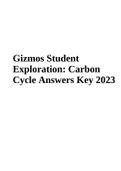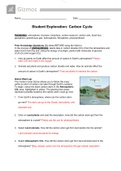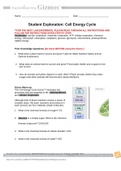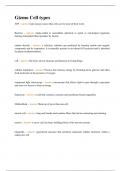Gizmo photosynthesis - Study guides, Class notes & Summaries
Looking for the best study guides, study notes and summaries about Gizmo photosynthesis? On this page you'll find 176 study documents about Gizmo photosynthesis.
Page 4 out of 176 results
Sort by

-
Gizmo questions and answers (2022/2023) graded A
- Exam (elaborations) • 3 pages • 2023
-
Available in package deal
-
- $8.99
- + learn more
Gizmo questions and answers (2022/2023) graded A how does light intensity affect oxygen production up to 40% increasing the light intensity increases the oxygen production. Beyond 40% there is no effect. how does temp affect oxygen production oxygen production is maximized around 25 degrees Celsius. Oxygen production goes down when temp is too hot or too cold. --- to much CO2 (hot) is bad and enzymes are stunted when too cold how does carbon dioxide levels affect oxygen production up to about ...

-
Gizmo Latest 2023 Graded A
- Exam (elaborations) • 4 pages • 2023
-
Available in package deal
-
- $8.99
- + learn more
Gizmo Latest 2023 Graded A Air mass Large body of air with a similar temp Air pressure Is equal to the weight of a column of air on a particular location Cold front A boundary between a warm air mass and a cold air mass High pressure system No clouds and warm Knot Measure of a wind Low pressure system Cloud and cold Precipitation Anytime thing that falls out of a cloud Warm front A boundary between a cold air mass and a warm air mass Carnivore Ana animal that eats only meat Consumer Any...

-
Gizmos Student Exploration: Carbon Cycle Answers Key 2023
- Exam (elaborations) • 8 pages • 2023
- Available in package deal
-
- $15.49
- + learn more
Gizmos Student Exploration: Carbon Cycle Answers Key 2023. atmosphere, biomass, biosphere, carbon reservoir, carbon sink, fossil fuel, geosphere, greenhouse gas, hydrosphere, lithosphere, photosynthesis Prior Knowledge Questions (Do these BEFORE using the Gizmo.) In the process of photosynthesis, plants take in carbon dioxide (CO2) from the atmosphere and water (H2O) from the soil. Using the energy of sunlight, plants build molecules of glucose (C6H12O6) and oxygen (O2). 1. How do plants on...

-
Gizmos photosynthesis Questions and Best Answered Solutions 2023/2024
- Exam (elaborations) • 1 pages • 2023
-
Available in package deal
-
- $7.99
- + learn more
Gizmos photosynthesis Questions and Best Answered Solutions 2023/2024 Which of the following can be used to measure the rate of photosynthesis? - Answer Oxygen production (mL/hr) Based on what you have observed in the Gizmo, which of the following chemical equations represents photosynthesis? - Answer Carbon dioxide plus water yields glucose (sugar) and oxygen.

-
Gizmos Student Exploration: Cell Types Answers Key 2023
- Exam (elaborations) • 18 pages • 2023
- Available in package deal
-
- $16.49
- + learn more
Gizmos Student Exploration: Cell Types Answers Key 2023. ATP, bacteria, carbon dioxide (CO2), cell, cellular respiration, compound light microscope, eukaryote, multicellular, muscle cell, neuron, organelle, photosynthesis, prokaryote, protist, red blood cell, root hair cell, tissue, unicellular, white blood cell Prior Knowledge Questions (Do these BEFORE using the Gizmo.) 1. How do you know if something is alive? Describe some of the characteristics of living things. Answer: It is alive if ...

-
Gizmos Student Exploration: Carbon Cycle Answers Key 2023
- Exam (elaborations) • 8 pages • 2023
-
- $15.49
- + learn more
Gizmos Student Exploration: Carbon Cycle Answers Key 2023. atmosphere, biomass, biosphere, carbon reservoir, carbon sink, fossil fuel, geosphere, greenhouse gas, hydrosphere, lithosphere, photosynthesis Prior Knowledge Questions (Do these BEFORE using the Gizmo.) In the process of photosynthesis, plants take in carbon dioxide (CO2) from the atmosphere and water (H2O) from the soil. Using the energy of sunlight, plants build molecules of glucose (C6H12O6) and oxygen (O2). 1. How do plants on...

-
Questions and Answers > SCIENCE 101Stephani DeBise - Carbon Cycling GIZMO
- Exam (elaborations) • 10 pages • 2023
-
- $6.49
- + learn more
SCIENCE 101Stephani DeBise - Carbon Cycling GIZMO Student Exploration: Carbon Cycle Vocabulary: atmosphere, biomass, biosphere, carbon reservoir, carbon sink, fossil fuel, geosphere, greenhouse gas, hydrosphere, lithosphere, photosynthesis Prior Knowledge Questions (Do these BEFORE using the Gizmo.) In the process of photosynthesis, plants take in carbon dioxide (CO2) from the atmosphere and water (H2O) from the soil. Using the energy of sunlight, plants build molecules of glucose (C6H12O6) and ...

-
Student Exploration Carbon Cycle GIZMO
- Summary • 5 pages • 2023
-
- $6.99
- + learn more
Student Exploration: Carbon Cycle Vocabulary: atmosphere, biomass, biosphere, carbon reservoir, carbon sink, fossil fuel, geosphere, greenhouse gas , hydrosphere, lithosphere, photosynthesis Prior Knowledge Questions (Do these BEFORE using the Gizmo.) In the process of photosynthesis, plants take in carbon dioxide (CO2) from the atmosphere and water (H2O) from the soil. Using the energy of sunlight, plants build molecules of glucose (C6H12O6) and oxyg...

-
GIZMOS | Student Exploration: Cell Energy Cycle 2023 (GRADED A+)
- Exam (elaborations) • 9 pages • 2023
-
- $9.49
- + learn more
Student Exploration: Cell Energy Cycle **FOR THE BEST LAB EXPERIENCE, PLEASE READ THROUGH ALL INSTRUCTIONS AND FOLLOW THE INSTRUCTIONS GIVEN STEP BY STEP! Vocabulary: aerobic respiration, anaerobic respiration, ATP, cellular respiration, chemical energy, chlorophyll, chloroplast, cytoplasm, glucose, glycolysis, mitochondria, photosynthesis, radiant energy Prior Knowledge Questions (Do these BEFORE using the Gizmo.) 1. What does a plant need to survive and grow? Light Air Water Nutrition S...

-
Gizmo Cell types questions and ready answers 2023/2024
- Exam (elaborations) • 2 pages • 2023
-
Available in package deal
-
- $11.49
- + learn more
Gizmo Cell types questions and ready answers 2023/2024 ATP - Answer main energy source that cells use for most of their work Bacteria - Answer single-celled or noncellular spherical or spiral or rod-shaped organisms lacking chlorophyll that reproduce by fission carbon dioxide - Answer a colorless, odorless gas produced by burning carbon and organic compounds and by respiration. It is naturally present in air (about 0.03 percent) and is absorbed by plants in photosynthesis. cell - Ans...

That summary you just bought made someone very happy. Also get paid weekly? Sell your study resources on Stuvia! Discover all about earning on Stuvia


